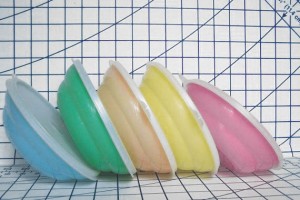Dupont chemist Earl Tupper had long dreamed of a line of home products made of plastic, but in spite of his endless experimentation, nothing seem durable or flexible enough to suit his needs. All of that changed with the invention of polyethylene in 1944. Within two years he completed his first two creations, the bathroom glass (the Bell Tumbler) and lidded storage bowls (the Wonderlier Bowl), and the world was introduced to Tupperware.
Unlike anything on the market, Tupper’s containers could be sealed air tight due to a lid patterned after the inverted rim on a paint can and the patented “burp” tab. This extended the shelf life of food, and as a bonus, the stackable containers saved space.
Sadly, the public response was as best, lukewarm. Tupper’s airtight concept was a stroke of genius that often went unappreciated sitting on a store shelf. The concept needed to be demonstrated. Modeled after the home party plan used by Stanley Home Products, the first Tupperware Party was held in 1948 and met with such success that in 1951 Tupper removed his wares from stores and the Tupperware Home Party became the exclusive outlet for sale of his line of home storage containers.
Tupperware and the stay-at-home moms of the 1950s were the perfect match. Women jumped at the chance to earn money from home selling a product they believed in. Even more, it provided the housewives of mid-20th Century America an opportunity to interact with their community as businesswomen in a manner that was considered acceptable.
As we entered the 1960s the woman’s role in society began a gradual change. While her responsibilities as a homemaker remained a priority, women now considered a double role as they stepped up their level of education and sought careers outside the home. With less time for household chores, convenience in food prep and storage became more important than ever and Tupperware was there to solve the problem.
For those of us who grew up with a kitchen full of Tupperware, it’s recent emergence as a collectible comes a quite a surprise. Tupperware in the antique malls? Believe it or not, it is there and it is selling! Savvy dealers are scarfing it up at yard sales this summer and, if the 2,000 plus pieces currently listed on eBay are any indicator, values are on the rise.
The most commonly found pieces include measuring cups and spoons, individual tumblers, lidded soup and cereal bowls and the early-60s “Microwave Reheatables.” These are retailing in the $10-$15 range. Food transport items such as the 1960s “Party Bowl,” “Pie Taker,” and the “Dip N’Serve” serving tray are increasing in value with a current asking price of $20-$40.
Many of the early issue sets have become separated over time, making them a challenge to the collector. Case in point are the “Servalier One-Touch” canisters. While they can be found separately for a few dollars, they are currently selling in the $45-$60 range as a set.
Tupperware continues to be produced today in 14 countries including the U.S. These newer pieces are of little interest to collectors who look for pieces produced prior to 1970. Do your research and hit the yard sales, as these little gems are everywhere for pennies on the dollar.
So what ever happened to Earl Tupper? In 1958 Earl sold the company for $16 million. In 12 short years, he had become a millionaire, revolutionized the way we preserve food and opened the door for an entire generation of women to step out into the work force. Thank you Earl! Until next time….Linda
Irvington resident Linda Kennett is a professional liquidation consultant specializing in senior down-sizing and the liquidation of estates and may be reached at 317-258-7835 or follow her on FB at lFaceBook at www.facebook.com/WhatsInTheAttic



